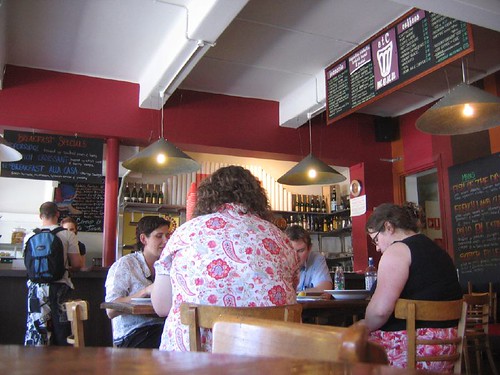NOTE THAT CORK IS NOW CLOSED
date of visit: Saturday 3 March 2012
Our dinner reservation was quite late (8:30pm) so it would have been plain rude NOT to go somewhere for a drink first. Cork Wine Café has been on my radar for a while – plenty of people I follow on twitter seem to be semi-regulars there and even my parents have been.
It is one of those awesome little hole in the wall style bars. There are a few tables outside (no use in our case, as it was chucking it down) and even fewer (I think) inside. But one was free and we ducked in and nabbed our spot.
Cork is pretty trendy but not so trendy we were put off. It’s all dim lighting and dark furniture with a long bar behind which sits a really impressive array of wines. The wine list isn’t arranged by varietals (you know – “Riesling”, “Sauvignon Blanc”) it’s arranged by wine styles, so if you fancy a “textural white” you know where to go. Initially I was really sceptical about this but I stopped my huffing and puffing for long enough to read the menu (sorry, wine list) and then I just got really excited.
Cork has loads of wine by the glass and the bar also offers tasting flights – if you simply cannot choose just one “textural white” then try three (in tasting measures) for a single price.
Which is what I should have done. But I was overexcited about the presence of a Picpoul de Pinet on the wine list (a grape variety from southern France which I’m pretty sure I haven’t tried before) and a grower Champagne. I was bouncing around in my seat trying to decide between the two (the price did it in the end – the Champers, at $20 a glass, was twice the price of the Picpoul). Andy’s choice of a Trumer Pils (from Austria) was a lot less traumatic.
I’m not going to write about the Picpoul (I thought it was fab) because this is a bar review. And that is what Cork is – a bar. Apparently if you turn up expecting it to be a dessert café you may get a slightly chilly reception. That was certainly not our experience – service was friendly and my parents report that the staff are knowledgeable.
As it’s a bar, there’s some very limited tapas style food available. As we were heading out for dinner, we didn’t try anything. But I’m more than happy to go back, have a glass of something interesting and sample some food.
And you know what? It won’t matter if the food is dire, because you go to Cork to drink.



